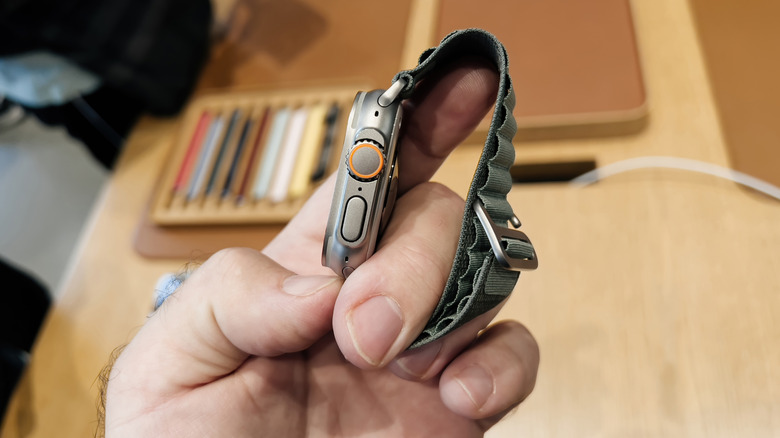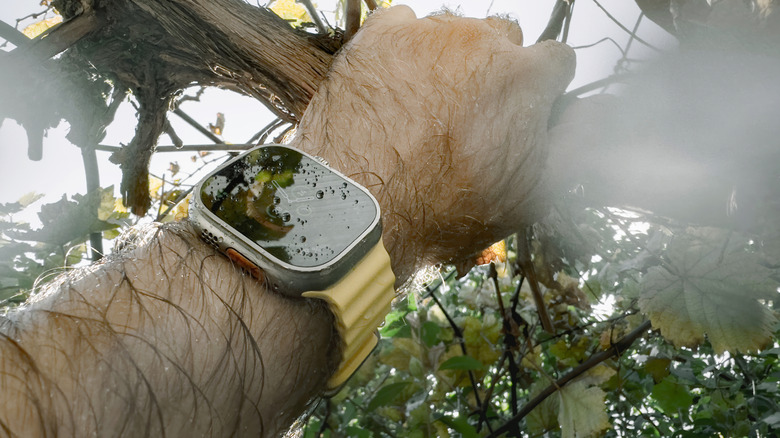What Is The Hole On The Side Of An Apple Watch For?
Since Apple released its first Watch model over a decade ago, it has evolved to become a leader in the wearable technology space. Through the years, Apple has made massive adjustments to its succeeding Watch models, including a lot of Apple Watch features that many of us probably don't know about, especially if they don't fit our lifestyle. From super mundane tasks, like a hand wash timer or helping navigate new cities, to being a remote for your iPhone, many of us have barely scratched the surface of what it can do. For this reason, its components may have unique applications tht surprise us, like the little holes on its sides.
According to Apple, these holes are actually meant to support three different functions: speaker, microphone, and in some models, water-depth measurement. Now, most people know that you can take calls, give Siri commands, or capture audio with your Apple Watch. Apart from these, the little microphone is also used to check for ambient noise and tell you when it's becoming too loud for comfort. But, while the first two are pretty straightforward, how does the little hole actually function as part of its water-depth measurement features? While not all Apple Watch models are made for frolicking in the water, here's how the ones that do actually work, how to activate that feature, and how to recognize its limitations.
How does the Apple Watch water-depth measurement work?
For newer models, such as the Series 2, SE, and Ultra variants, there's a lot more leeway for summer fun, especially with the latter. In fact, this is just one of the many reasons why we think the Apple Watch Ultra is made for Apple fans with more adventurous lifestyles. One interesting feature? Water-depth measurement.
In tandem with the Apple Watch Depth app, the little hole on the side of your Apple Watch helps you know three additional details when you're underwater: how long you've been submerged, current depth versus maximum depth, and the temperature. Plus, of course, the Watch acts like a watch and can tell you the time. While you can probably push the boundaries a little bit, the depth measurement helps protect your device and serves as a warning when it reaches its measurement capacity. When all conditions are met, Apple says that its Watch models have sensors that have a +/- 1 meter accuracy.
To start using water-depth measurement features on your dives, you can either manually open the Depth app or activate it via the Action button. Alternatively, if you've set up Auto-Launch, your Watch will automatically access this feature once you reach the one meter mark and have been under for at least five seconds. That said, the main reason Apple doesn't recommend it as a dive watch replacement is because it doesn't provide key information, like decompression stops.
What Apple Watch models use the hole for water-depth measurements?
As of this writing, Apple shares that there are two models that work with the Depth app: the Apple Watch Series 10 and the Apple Watch Ultra models. However, the key difference is how deep each one can go. The Apple Watch Series 10 can only go up to 20 ft, which makes it ideal for free-diving or snorkeling, since even an open water scuba diving certification lets you go thrice as deep at 60 feet. On the other hand, the Apple Watch Ultra is made of sterner stuff, since it's rated with a maximum depth limit of 130 feet, which is about PADI's recreational limit. In addition, it is rated to be safely used underwater with temperatures of 32 to 104 °F. Alternatively, there are also a lot of third-party diving apps, like Oceanic+ and Garmin Dive.
It's important to note that waterproofing for any device isn't foolproof, and the materials used to keep your device safe from water damage may falter over time, especially if you tend to use it regularly under tough conditions. That said, it is possible to prevent the damage from happening sooner rather than later by not plugging this hole unnecessarily with earrings, toothpicks, or safety pins. Not to mention, there are plenty of other things you can do to elongate your Apple Watch's overall lifespan as well, like cleaning it regularly, not exposing it to extreme temperatures for long periods, and staying under the maximum depth ratings.


